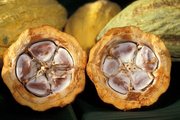Cacao
|
|
| Cacao | ||||||||||||||
|---|---|---|---|---|---|---|---|---|---|---|---|---|---|---|
| Missing image Theobroma_cacao-frutos.jpeg Cacao tree with fruit pods | ||||||||||||||
| Scientific classification | ||||||||||||||
|
Cacao (Theobroma cacao) is a small (4-8 m tall) evergreen tree in the family Malvaceae (formerly Sterculiaceae), native to tropical South America, but now cultivated throughout the tropics. Its seeds are used to make cocoa and chocolate.
The tree grows naturally in the low foothills of the Andes at elevations of around 200-400 m in the Amazon and Orinoco river basins; it was introduced to Central America by the Maya people. It requires a humid climate with regular rainfall and good soil. It is an understorey tree, growing best with some overhead shade. The leaves are alternate, entire, unlobed, 10-40 cm long and 5-20 cm broad.
Theobroma_cacao2.jpg
The flowers are produced in clusters directly on the trunk and older branches; they are small, 1-2 cm diameter, with pink calyx. The fruit, called a cacao pod, is ovoid, 15-30 cm long and 8-10 cm wide, ripening yellow to orange, and weighs about 500 g when ripe. The pod contains 20 to 60 seeds, usually called "beans", embedded in a white pulp. Each seed contains a significant amount of fat (40-50% as cocoa butter). Their most important active constituent is Theobromine, a compound somewhat similar to Caffeine.
The scientific name Theobroma means "food of the gods", while cacao probably comes from the Yucatec Maya word cacau.
Cultivation
Cacao is planted on over 70000 square kilometres worldwide with 40% of production coming from Côte d'Ivoire. Ghana and Indonesia each produce about 15%, with smaller amounts from Brazil, Nigeria and Cameroon.
A tree begins to bear when 4 or 5 years old. In one year, when mature, it may have 6,000 flowers, but only about 20 pods. About 300-600 seeds are required to produce around 1 kg of cocoa paste.
There are three main cultivar groups of cacao beans used to make cocoa and chocolate. The most prized, rare, and expensive is the Criollo Group, the cocoa bean used by the Maya. Only 10% of chocolate is made from the Criollo, which is less bitter and more aromatic than any other bean. The cacao bean in 80% of chocolate is made using beans of the Forastero Group. Forastero trees are significantly hardier than Criollo trees, resulting in cheaper cacao beans. Trinitario, a hybrid of Criollo and Forastero, is used in about 10% of chocolate. For details of processing, see cocoa.
Theobroma_cacao.jpg
Cacao beans were commonly used as currency in Pre-Columbian Mesoamerica. In some areas, such as Yucatán, they were still used in place of small coins as late as the 1840s.
External links
Template:Commonsde:Kakao es:cacao fa:کاکائو fr:Cacaoyer he:קקאו (עץ) it:Theobroma cacao ja:カカオ ms:koko nl:Cacaoboon nn:Kakao pl:kakaowiec lt:kakava pt:Cacau sr:Какао sv:Kakao zh:可可

